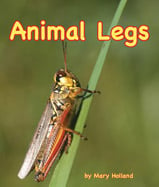Alignment to Standards for MD

| Grade | Number | Standard |
|---|---|---|
| 1 | SC-1.3.0.A.1. | Compare and explain how external features of plants and animals help them survive in different environments. |
| 1 | SC-1.3.0.A.1.b | Compare similar features in some animals and plants and explain how each of these enables the organism to satisfy basic needs. |
| 1 | SC-1.3.0.A.1.c | an organisms external features contribute to its ability to survive in an environment. |
| 1 | SC-1.3.0.B.2.a | humans and other animals have different body parts used to seek, find, and take in food. |
| 1 | SC-1.3.0.B.2.b | identify parts of the body that alert humans and other animals to danger and help them to fight, hide or get out of danger. |
| 1 | SC-1.3.0.E.1. | Describe some of the ways in which animals depend on plants and on each other. |
| 1 | SC-1.3.0.E.1.a | Examine organisms in a wide variety of environments to gather information on how animals satisfy their need for food. |
| 2 | SC-2.3.0.F.1.b | Explain that organisms live in habitats that provide their basic needs: Food, Water, Air, Shelter |
| 4 | SC-4.3.0.A.1.a | a variety of animals or plants in both familiar and unfamiliar environments. |
| 4 | SC-4.3.0.D.1.a | Describe ways in which organisms in one habitat differ from those in another habitat and consider how these differences help them survive and reproduce. |
| 4 | SC-4.3.0.F.1.a | Explain ways that individuals and groups of organisms interact with each other and their environment. |
| 4 | SC-4.3.0.F.1c | Identify and describe the interactions of organisms present in a habitat: Beneficial interactions: nesting, pollination, seed dispersal, oysters filtering as in the Chesapeake Bay, etc. |
| 4 | SC-4.3.0.F.1d | Identify and describe the interactions of organisms present in a habitat: Roles within food chains and webs: scavengers, decomposers, producers, consumers. |
| 5 | SC-5.3.0.E.1. | Recognize that some source of energy is needed for all organisms to grow and survive. |
| 5 | SC-5.3.0.E.1.d | some insects and various other organisms depend on dead plant and animal material for food. |
| K | SC-K.3.0.A.1.a | features (observable parts) of animals and plants that make some of them alike in the way they look and the things they do. |
| K | SC-K.3.0.A.1.b | features that make some animals and some plants very different from one another. |
| K | SC-K.3.0.A.1.d | Compare ideas about how the features of animals and plants affect what these animals are able to do. |
| K | SC-K.3.0.A.2.c | similarities in what both humans and other animals are able to do because they possess certain external features. |
| K | SC-K.3.0.D.1.b | describe and compare living things found in other states such as Texas and Alaska to those found in Maryland. |
| K | SC-K.3.0.E.1. | Develop an awareness of the relationship of features of living things and their ability to satisfy basic needs that support their growth and survival. |
| K | SC-K.3.0.E.1.a | Make observations of the features and behaviors of many different kinds of animals within an environment to identify and begin building a list of some of the basic needs these organisms share, such as water, air, etc. |
| K | SC-K.3.0.E.1.b | Describe ways that people and other animals manage to bring the things they need from their environment into their bodies. |
| K | SC-K.3.0.F.1.c | Describe ways that animals and plants found in each place interact with each other and with their environment. |
| K | SC-K.5.0.A.1. | Compare the different ways objects move. |
| PK | SC-PK.3.0.A.1. | familiar plants and animals to describe how they are alike and how they are different. |
| PK | SC-PK.3.0.A.1.a | how some animals are alike in the way they look and in the things they do. |
| PK | SC-PK.3.0.A.1.d | Identify some of the things that all animals do, such as eat, move around and explain how their features (observable parts) help them do these things. |
| PK | SC-PK.4.0.A.1. | Use evidence from investigations to describe the observable properties of a variety of objects. |
| PK-2 | SC-PK-2.1.0.D.3.b | Realize that one way to describe something is to say how it is like something else. |